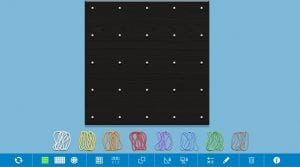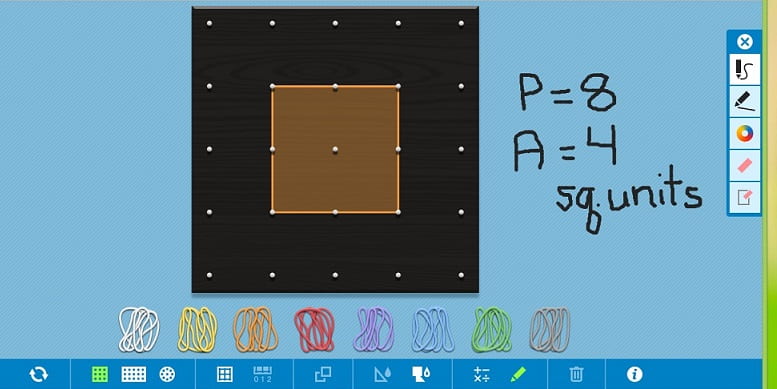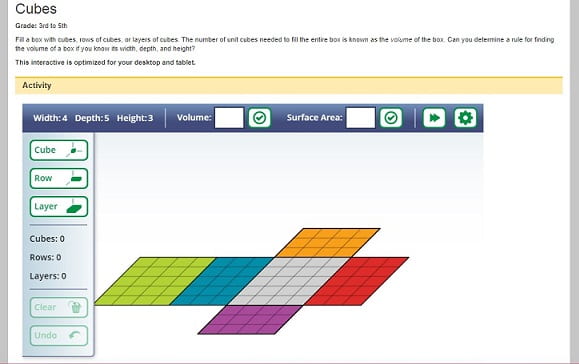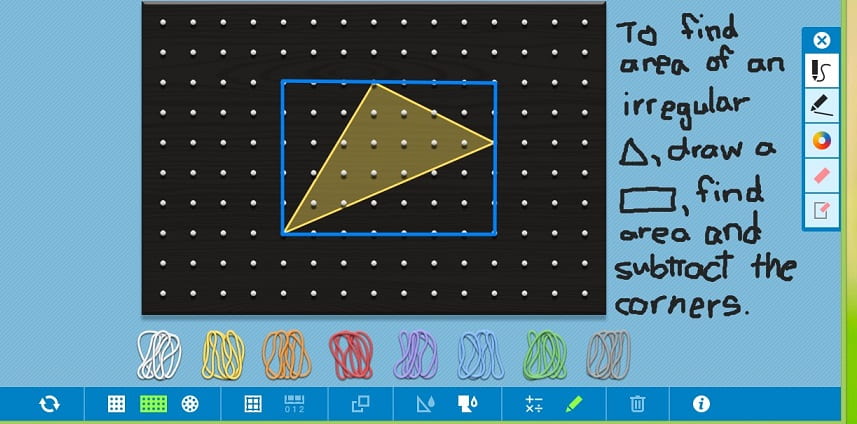by C. Elkins, OK Math and Reading Lady
There are several great math websites which might help you and your students with geometry and measurement standards such as area, perimeter, volume, surface area, angles, etc. The ones I am recommending are interactive and often customizable. Check them out!! (Each title can be clicked to take you directly to the linked website.)
- Geoboard by The Math Learning Center: I love the concept of geoboards to help children create polygons and measure area and perimeter. However, most teachers have ditched their physical geoboards. They are often in boxes relegated to the basement storage areas. I get it, though. They take up a lot of shelf space in the class, there aren’t enough rubber bands to go around (aka geobands), the kids misuse them or break them, they don’t stretch far enough, the pegs get broken, etc.
I think you will LOVE this app. Check out the little “i” on how to get the most use out of it, but it has 2 variations for the board size and you can show it with/without gridlines or numbers. There are different colored bands which you drag to the board and stretch to whichever pegs you need. You can shade in areas, copy, and rotate (which is helpful to see if 2 similar shapes are equivalent). There is also a drawing palette in case you want to freehand something or draw lines (and with different colors as well).
Check out the little “i” on how to get the most use out of it, but it has 2 variations for the board size and you can show it with/without gridlines or numbers. There are different colored bands which you drag to the board and stretch to whichever pegs you need. You can shade in areas, copy, and rotate (which is helpful to see if 2 similar shapes are equivalent). There is also a drawing palette in case you want to freehand something or draw lines (and with different colors as well).
What are the possibilities with this?
- Use with primary students to create squares, rectangles, and other polygons. The teacher can elicit different responses with directions such as: Make a square. Make a different size square. Make a trapezoid. Are any of our trapezoids the same?
- Creations can sometimes be recorded on dot paper – although I would reserve this for less-complicated shapes.
- Count the pegs around the shape to determine perimeter. The teacher might ask students to create a rectangle with a perimeter of 10 (or 12, or another amount). How many different ways are there? Be cautious with diagonal connections because they are not equivalent to vertical or horizontal connections. Think of how you can get students to discover this without just telling them.

- Show the gridlines to help students determine area. Initially, students may just count the squares inside the shape. Guide students to more efficient ways to figure this (multiplying, decomposing into smaller sections, etc.).
- This app is also great for creating irregular shapes in which students may decompose into smaller rectangles or triangles. Then check them with the standard formulas.
2. “Cubes” at NCTM’s site (Illuminations): This one is perfect for volume and surface area.
- Volume: You can use the gear symbol to select the size (l, w, and h) of the rectangular prism, or use the default ones shown. Then there are 3 tools used to fill the rectangular prism: individual cubes, rows of cubes, or layers of cubes. I prefer using the layer tool to support the formula for volume as: area of the base x height. The base is the bottom layer (which can be determined by looking at the length x the width). The height is the number of layers needed to fill the prism. Once you compute the volume, enter it and check to see if it is correct.
- Surface Area of Rectangular Prism: To calculate the surface area, you must find the the area of each face of the prism. Again, you can customize the size using the gear tool. I prefer this as the shapes shown randomly often are too small to see. Yes, there is a formula for surface area — but conceptually we want students to note the surface area can be thought of in three parts. With a click on each face, this app opens (or closes) a rectangular prism into the 6-faced net making it easier to see the equal sized sections:
- Area of the front and area of the back are the same
- Area of the top and area of the bottom are the same
- Area of each side is the same
- Be sure to explore what happens when the prism is a cube.



3.Surface area with Desmos: This link provides an interactive experience with surface area, using a net. This time, the three visible faces of the prism are color coded, which helps with identifying top / bottom; front / back; and side / side. The prisms on this site are also able to be changed so students can see how altering one dimension affects the surface area.
6. “Plane Figures” on GeoGebra
These three may be more relevant to middle school math standards. Check them out!! Also take a look at the “Resources” link (left side of web page). There are plenty of other good links for arithmetic standards as well – too many to list here. You may have to create a log-in, but it’s FREE!
Enjoy! Do you have other websites to recommend? Let us know.




Individualized instruction is not only to enhance Math skills but also to prepare kids for success. An online math tutor program will assist children to achieve it.